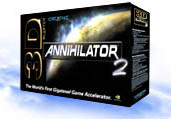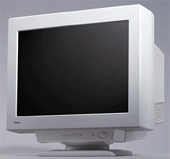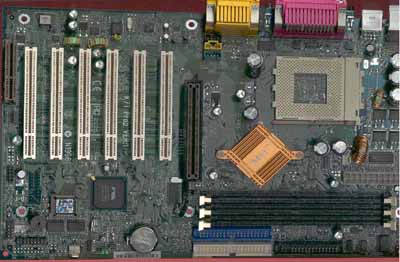Buyer's Guide: High-End Systems - December 2000
by Mike Andrawes on December 24, 2000 2:52 PM EST- Posted in
- Guides
High-end Gaming System
The purpose of
this system is simple – maximum frame rates at all costs. Of course, we already
have a “cost is no object” dream system, so "all costs" isn't taken
quite so literally. We’ve decided to shoot for a price in the $3500 range on
the high-end gaming system. That price is without floppy, keyboard, mouse,
or software. Even though it’s not in the price, we will recommend an OS configuration.
 Processor
– AMD Athlon "Thunderbird" 1.1 GHz - $250
Processor
– AMD Athlon "Thunderbird" 1.1 GHz - $250
Clock for clock,
the Athlon may be a bit slower than the Pentium III at games. However, at similar
clock speeds, the Athlon holds a significant advantage in price, and for that
reason, we’ve chosen a Socket-A Athlon 1.1 GHz, which means that it's using
the new Thunderbird core with on-die cache. It's hard to believe we're already
recommending over a 1 GHz processor so soon, but AMD has dropped prices to the
point where buying anything less for such a machine simply doesn't make a whole
lot of sense.
Besides the direct performance benefits of full speed on-die cache, we also get the side benefit of enhanced overclockability. If you're willing to overclock our CPU, you can save some money by going with the 700-800 MHz model, most of which will hit 900 - 950 MHz at default voltage, all without exotic cooling. A 900 MHz may overclock a bit better if you're lucky enough to get one with copper interconnects.
For more information on all Athlon processors, read our Athlon "Thunderbird" 1.2GHz & Duron 800 MHz Review and our Thunderbird / Duron Overclocking Guide.
Motherboard – Microstar
K7T Pro2A - $130
The availability of AMD 760 motherboards
is still non-existant for the "do it yourself" market for the time
being, so we'll have to wait at least until early next year before DDR SDRAM
systems make an appearance here. Boards using the KT133A
should be here even sooner, however, and it looks like they'll offer 90% of
the performance of DDR SDRAM using standard PC133 memory. To top it off, KT133A
boards should cost about the same as current KT133 boards since the North Bridges
are pin compatible and the same PCB layout can be used in most cases.
The VIA KT133 is here now and is the best chipset for the Athlon right now. We recently had our second KT133 Socket-A Motherboard Roundup where we looked at as many boards as we could get a hold of. Once again, one board stood out head and shoulders above the rest, but this time it was the MSI K7T Pro2 edging out the previous champ ABIT KT7-RAID. The key to overtaking the KT7-RAID was the excellent stability of the K7T Pro2, which surprassed all other KT133 boards we've tested to date, and the long awaited addition of multiplier adjustments for overclocking purposes.
The K7T Pro2A that we've chosen here is the same as the K7T Pro2 but with VIA's 686B South Bridge replacing the old 686A and thus adding Ultra ATA/100 support. There's no on-board RAID support, but that doesn't matter much here because hard drive performance is generally not a major bottleneck in games.
The former champ, ABIT KT7-RAID, is certainly still a very good choice, as is the ASUS A7V for their solid stability and excellent feature sets, including optional on-board RAID controllers.. The EPoX EP-8KTA2, Soyo K7VTA, and FIC AZ11E are also decent choices for overclockers thanks to their multiplier controls and they'll save you a few bucks even.
For more information, read our ABIT KT7-RAID Review, ASUS A7V Review, MSI K7T Pro2 Review, and Socket-A KT133 Motherboard Roundup.
Memory – 256MB Corsair
or Mushkin CAS2 PC133 SDRAM – $200
Even though memory
is relatively cheap these days, 256MB is more than enough. We could have dropped
down to 128MB, but the savings didn’t justify the performance loss. Besides,
this is our high-end gaming machine, and there’s room in the budget.
As for the exact brand of memory, we recommend Corsair or Mushkin modules. We use them in our test systems and have had absolutely no problems with them.
 Video
card – Creative Labs 3D Blaster Annihilator 2 - $200
Video
card – Creative Labs 3D Blaster Annihilator 2 - $200
Once again, the
Radeon vs GeForce 2 GTS question comes up and once again NVIDIA gets the nod
for their solid driver support.
The majority of GeForce 2 GTS cards on the market are retailing for $300 and selling closer to $250. Creative has undercut the competition with a retail price of $250 and street price closer to $200. True, it's just a plain jane card, with no TV-in/out, but it gets the job done and is the most overclockable GeForce 2 GTS we've tested to date. We were able to push our sample up to 250/395 MHz (core/memory), making it the first 2 Gigatexel (theoretical fillrate) card in the AnandTech lab.
The GeForce2 Pro is another viable option, but it costs a full $100 more than a standard GTS card. Of course, that $100 does give you 32MB more memory and a faster memory clock speed. The Hercules Prophet II Pro is the easiest GeForce2 Pro to get a hold of at the moment, but ASUS, Leadtek, and others should be showing up any time now as well. Note that Creative Labs has stated that the GeForce2 Pro was intended only for the OEM market and, thus, they will not be releasing a card based on this chip.
For more information, read our Annihilator 2 Review, GeForce 2 GTS Overclocking Guide, and GeForce 2 GTS Review.
 Monitor
– iiYama VisionMaster PRO 450 - $450
Monitor
– iiYama VisionMaster PRO 450 - $450
Using a Mitsubishi
Diamondtron NF, the iiYama VisionMaster Pro 450 provides a perfectly flat display
surface using the same technology in Sony’s FD Trinitron models, but at a lower
cost. The VisionMaster PRO 450 is a 19” monitor and has been highly acclaimed
here on AnandTech and by owners alike. If you’ve got the funds, we highly recommend
you go with the 22” VisionMaster PRO 510 for about $900.
For more information, read our iiYama VisionMaster PRO 450 and VisionMaster PRO 510 Reviews.











0 Comments
View All Comments